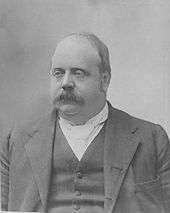Free Trade Party
Free Trade Party | |
|---|---|
| Historic leaders |
Henry Parkes, George Reid, Joseph Cook |
| Founded | 1887 |
| Dissolved | 1909 |
| Merged into | Commonwealth Liberal Party |
| Headquarters | Canberra |
| Ideology |
Liberalism Free trade Anti-socialism |
| Political position | Centre-right |
| International affiliation | None |
The Free Trade Party which was officially known as the Australian Free Trade and Liberal Association, also referred to as the Revenue Tariff Party in some states and renamed the Anti-Socialist Party in 1906, was an Australian political party, formally organised between 1887 and 1909. It advocated the abolition of protectionism, especially protective tariffs and other restrictions on trade, arguing that this would create greater prosperity for all. However, many members also advocated use of minimal tariffs for government revenue purposes only. Its most prominent leader was George Reid, who was the fourth Prime Minister of Australia.
History
The party was centred on New South Wales, where its leaders were Sir Henry Parkes and Sir George Reid. It dominated New South Wales colonial politics before federation. It first contested the 1887 New South Wales election.
In the elections for the first Commonwealth Parliament, the Free Traders, who campaigned in some states as the Revenue Tariff Party, formed the second largest group in the Australian House of Representatives, with 25 seats. Reid became the Parliament's first Opposition Leader with William McMillan as his deputy, later becoming Prime Minister in 1904–05. Joseph Cook became deputy leader of the party on McMillan's retirement in 1903.
A separate Tasmanian Revenue Tariff Party contested the 1903 federal election in Tasmania and won two seats but also sat and merged with the Free Trade Party in federal Parliament.
After the question of tariffs had largely been settled, Reid cast around for another cause to justify his party's existence. He settled on opposition to socialism, criticising both the Australian Labour Party and the support offered to it by the Protectionist Party, led by Alfred Deakin. Reid adopted a strategy of trying to reorient the party system along Labour vs non-Labour lines – prior to the 1906 election, he renamed his Free Trade Party to the Anti-Socialist Party. Reid envisaged a spectrum running from socialist to anti-socialist, with the Protectionist Party in the middle. This attempt struck a chord with politicians who were steeped in the Westminster tradition and regarded a two-party system as very much the norm.[1]
The Labor Party and the FTP/ASP continued to grow in electoral strength at the expense of the Protectionist vote. Some Protectionists continued their exodus to Labor and the ASP.

When Deakin proposed the Commonwealth Liberal Party, a "Fusion" of the two non-Labour parties, Reid resigned as party leader on 16 November 1908. The following day, Joseph Cook was made leader until the parties merged.[2]
Electoral results
Parliament of Australia
| House of Representatives | ||||||
| Election year | # of overall votes |
% of overall vote |
# of overall seats won |
+/– | Leader | |
|---|---|---|---|---|---|---|
| 1901 | 151,960 (#2) | 30.03 | 28 / 75 |
|
| |
| 1903 | 247,774 (#1) | 34.37 | 24 / 75 |
|
| |
| 1906 | 363,257 (#1) | 38.17 | 26 / 75 |
|
| |
| Senate | ||||||
| Election year | # of overall votes |
% of overall vote |
# of overall seats won |
+/– | Leader | |
|---|---|---|---|---|---|---|
| 1901 | 1,053,012 (#2) | 39.44 | 17 / 36 |
|
| |
| 1903 | 986,030 (#1) | 34.33 | 12 / 36 |
|
| |
| 1906 | 1,384,662 (#1) | 46.53 | 14 / 36 |
|
| |
See also
| Wikimedia Commons has media related to Free Trade Party. |
- Liberalism in Australia
- Liberalism worldwide
- Australian federal election, 1901
- New South Wales colonial election, 1887
References
- McMinn, W. G. (1998). "Reid, Sir George Houstoun (1845–1918)". Australian Dictionary of Biography. Canberra: Australian National University. Retrieved 19 July 2012.